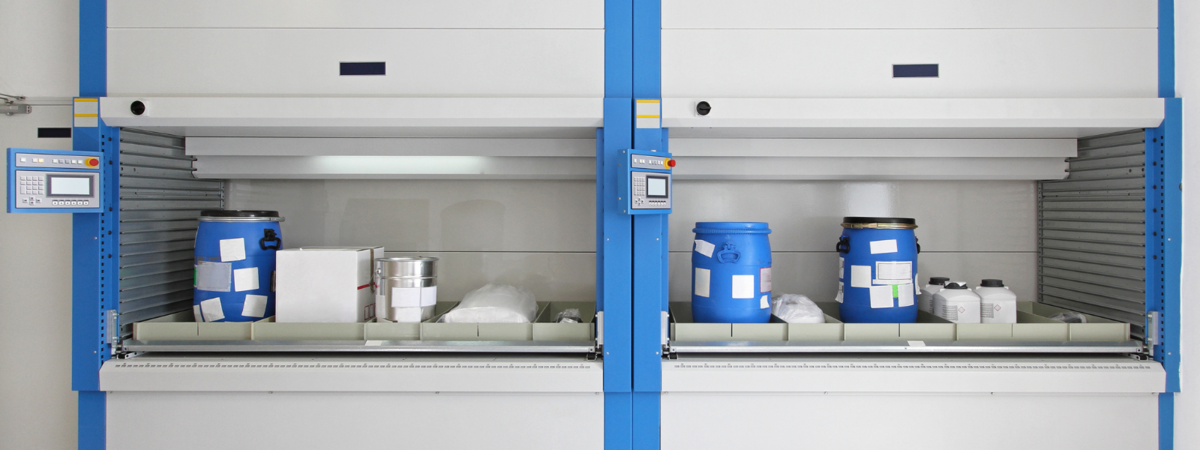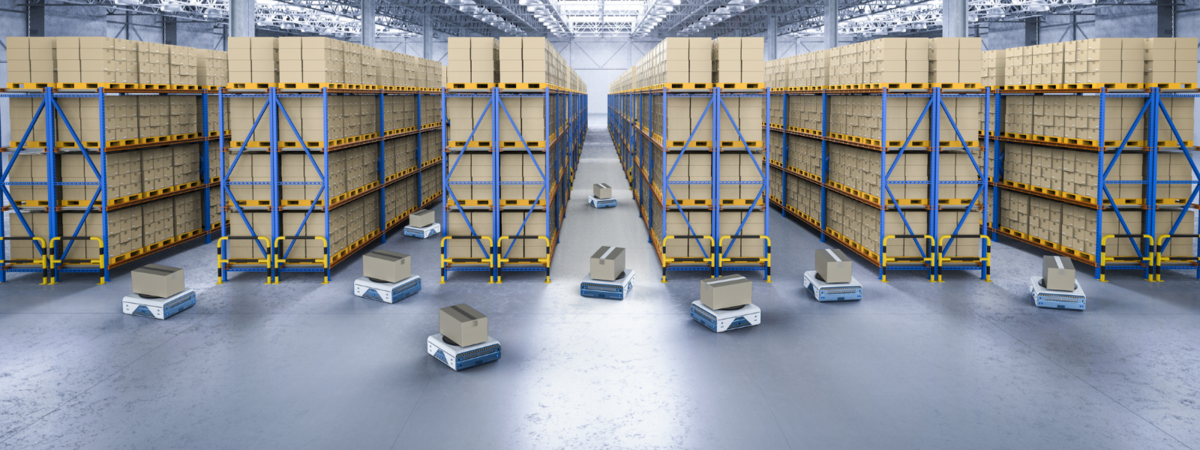6 Leading Trends in Warehouse Management and Warehouse Automation for 2023
2023-02-17
The new year brings new challenges which warehouse managers and operators will have to face. We picked the 6 most dominant trends that businesses with their own warehouses should focus on.
After an intense two years of the pandemic, the pressure on warehouse processes and supply chains did not ease even in the past 2022. Instead of remediating the consequences of the pandemic, warehouse managers and warehouse operators had to face additional challenges again. The situation of permanent crisis management will not decline even with the arrival of the new year 2023.
We already know that
- the ongoing energy crisis,
- war in Ukraine
- and a constant shortage of employees
will require
- prudent investments,
- precise work with company resources
- and adaptation of supply strategies
for a volatile period.
Despite these operational obstacles, market and customer demands for the provided services will continue to rise.
They mainly apply to
- pro-customer orientation, i.e. expanding services and increasing client comfort
- as well as much more flexible management of supply chains and logistics flows.
Simultaneously, data-driven supply management and relatively precise predictions will become the dominant form of decision-making, which will apply primarily to
- inventory management,
- order management
- and (re)organization of the warehouse.
Considering the previous year and the expected events, we looked at the key trends that will dominate at
- warehouse management,
- warehouse automation
- and digitalization of logistics
throughout 2023.
1. OMNICHANNEL LOGISTICS FUELED BY RISING DIGITAL RETAIL
The growth of online retail is not only a lingering legacy of the pandemic. Considering the
- advanced level of digitization,
- available applications and platforms for online sales
- as well as other digitization options
online selling are becoming the daily norm. This is also why experts expect exponential growth of the e-commerce industry during 2023, despite high inflation. Although 1%-2.3% growth is expected during the first half of the year, the rate of online sales should increase to 3.6%-4.7% in the second half of the year.
One of the significant aspects of the increase in online sales is also
- inventory management and control
- and digital warehouse automation,
which are easier than ever thanks to available software solutions.
Additionally, the convenience of online shopping increases the number of customers, which ultimately creates even more demand for online retail services.
On the other hand, the growing number of online sellers and the competition between them will create an even greater demand for extended services and their quality. It will be possible to satisfy this demand with omnichannel logistics.
A combination of different purchase options
- in virtual
- as well as physical space
along with other alternative sales channels push the concept of omnichannel sales to the level of a common standard.
This means that when expanding sales channels, companies need to rethink
- current logistics and supply processes,
- technologies used to secure them,
- information and data infrastructure supporting sales activities with order management.
In order for a company to successfully transition to an omnichannel sales model and ensure its required performance, it must adapt and in most cases also innovate
- warehouse management,
- distribution center management,
- or fulfillment logistics.
Procedures of
- multichannel
- and omnichannel logistics
present more complex challenges compared to linear picking in conventional single-channel sales. However, currently, they are among the most effective forms of serving diverse customer segments in considerable volumes at once. And their importance will continue to grow during the year 2023.
2. ADAPTATION OF LOGISTICS TO SUBSCRIBER SERVICES
In recent years, subscription services have become increasingly popular among consumers.
The subscription (membership) model, in addition to services such as
- streaming movies and series,
- visiting fitness centers
- or playing video games
is becoming more and more widespread even with more traditional, and especially non-digital, goods.
This opens up a new segment where is already a significant demand for the so-called retail subscription - "e-tail subscription". E-tail is short for "electronic retailing".
You can already subscribe
- books,
- clothes,
- cosmetic products and drugstore goods,
- toys
- or pet products.
Customers can receive in their regular shipment
- pre-announced item types,
- items from the seller's precise curation,
- or personalized goods based on predefined personal preferences.
They can also receive several items per month or receive them in the form of a subscription box that can contain several different types of items. From the point of view of sellers, it is also about creating a unique customer experience, especially with the so-called mystery boxes. The customer has no idea in advance exactly what goods he will receive, he only knows the focus (video games, pop culture or clothing).
This purchasing model is part of a wider shift across the industry. It concerns
- the transition from the push strategy - sellers create an inventory from which customers select items
- to the pull strategy - the seller already knows in advance what items he will sell and ship to customers.
Adaptation of logistics processes is inevitably related to this purchasing behavior.
The change in logistics is not linked to predicting the turnover rate of specific items or ensuring their availability in warehouses, but primarily to
- kitting services,
- packaging and repackaging
- and delivery options.

3. DEFRAGMENTATION OF THE WAREHOUSE TO REDUCE DELIVERY TIMES
Currently, the competitive battle between online and traditional sellers also takes place on the field of the shortest delivery time.
And when shopping, customers lean toward those sellers who provide
- greater customer comfort
- and the shortest delivery times.
To adapt to customer expectations, operators in online sales as well as in brick-and-mortar stores must be properly equipped.
First of all, they need a fast ERP system that is able to process incoming orders promptly and efficiently.
Secondly, they need an equally powerful WMS system that manages the picking of orders and their dispatch just as effectively.
The demand for increasingly shorter delivery times creates enormous pressure on inventory management and last-mile logistics infrastructure. Sellers, therefore, expand the alternatives for how customers can receive their order in suitable
- place,
- time
- and order acceptance form.
One of the ways to prepare for fluctuating volumes of orders in and out of season without having a negative impact on delivery time is to defragment the inventory.
Defragmentation of the warehouse is a sophisticated form of "cleaning" the warehouse based on accurate data on stock movements, and their handling as well as a detailed analysis of orders. Simultaneously, it is part of the data-driven warehouse concept, i.e. management of storage processes based on relevant data. Defragmentation of the warehouse can be part of a deep warehouse audit, which also gives answers to the connections between items and logistics processes.
The most frequent output is a reorganization proposal of
- the warehouse,
- processes
- or technologies,
so that the new layout suits the likely customer buying behavior and market requirements as much as possible.
Additionally, this form of audit provides answers to key questions in terms of planning and effective management of processes and resources:
- what types of supplies
- in what quantities
- and in what periods
it makes business sense to keep it in stock and at which specific warehouse locations.
The analysis also includes a proposal to remove goods that are not being sold enough or whose dimensions and storage requirements slow down the flow so much that it is inefficient to keep them in stock.
Advanced WMS systems already have a warehouse defragmentation function. In addition, this function can be automated, which means that the WMS system can generate a new layout of the warehouse not only
- for the next quarter,
- summer or winter season,
- for the following month, week
- but also for the next work shift.

4. DEEP DATA ANALYSIS FOR A MORE PERFORMING WAREHOUSE
Digitization has brought much greater
- clarity
- and transparency
also into warehouse and supply management.
Managers and operators of warehouses currently have much more accurate information and data available on the basis of which they can make
- qualified
- and strategic decisions.
Thanks to data analysis, warehouse managers have a panoramic view of what is happening in their warehouses and stocks in real time, including
- storage and transport costs,
- performance of warehouse operations,
- status of customer orders
- and other important factors,
which ensure a timely and error-free process of
- stockpiling of supplies,
- preparation of goods,
- completion of orders,
- and shipping customer shipments.
Data analytics uncover hidden and recurring patterns in warehouse processes that might
- minimize errors,
- optimize the efficiency of processes
- and identify best practices with regard to the ergonomics of warehouse operations.
As businesses place more and more emphasis on decision-making based on real data, data analytics for warehouse management stands out as an invaluable tool for achieving competitiveness.
Current advanced WMS systems generate a large volume of data. From this data, logistics managers or warehouse operators can create prediction models with the help of machine learning and intelligent algorithms. And above all for:
- expected turnover for the coming period,
- organization of the warehouse according to categories of goods, such as the best-selling goods or items that are most often ordered or picked together,
- ideal stock levels for individual periods.
Currently, companies still do not sufficiently use the potential that a deep analysis of the warehouse and warehouse processes provides. Companies that are not yet preparing a larger automation project for their storage processes also benefit from a warehouse audit.
A warehouse audit will reveal
- the most common errors in stocking, preparing, and dispatching orders,
- bottlenecks
- duplicate operations,
- inefficient picking routes,
- ineffective technologies,
Identification, as well as quantification of the most painful points in the warehouse, will make it possible to develop a set of accurate and effective ones
- fast
- and structural reforms
which will help with the fast
- optimizing picking performance,
- improving the efficiency of processes
- and simultaneously save a portion of the operating costs.
Each warehouse is unique, which is why corrections should be addressed and based exclusively on data from the relevant warehouse. When trying to get inspired for better warehouse management, it doesn't make sense to do it in someone else's warehouse. The most common audit results are:
- standardization of key processes,
- modification of the methods of relevant warehouse activities,
- reorganization of stock storage,
- new recalculation of the levels of selected stocks,
- adaptation of the shelf hierarchy,
- adaptation of horizontal storage,
- new redistribution of storage zones,
- change of picking and storage trajectories.
The acquisition of this knowledge can be automated by advanced WMS systems, as depending on the type of goods there may be
- regular changes in customer quantities
- or market preferences of specific goods with regard to other externalities.

5. STRENGTHENING OF WAREHOUSE FLEXIBILITY
During turbulent periods, demands on storage space also increase. Sellers can have a radical difference in seasonal and off-season volume, and thus productivity, in
- order quantities
- but also the types of stored and picked items.
This is also why they need storage space that can adapt to their current or expected requirements. Especially in a period of rising energy costs, it is not pragmatic to pay for unused space.
One of the ways is the reorganization of the warehouse and inventory according to
- detailed warehouse analysis,
- and predictive forecasts for the following periods.
The trend for 2023 is "doing more in a smaller space".
In practice, this means maximizing the usability of the entire space that the company currently has available, also considering
- the planned volumes of picked goods
- and other associated services or processes.
There are several ways to increase the flexibility of the warehouse.
Among the most widespread, which will also come to the fore this year are:
- preference for vertical storage and use of above-ground spaces (e.g a mezzanine),
- deployment of automation technology such as autonomous mobile robots (AMR),
- the use of sophisticated storage technologies, automated storage and retrieval systems such as AutoStore
- or installation of automatic sorting and distribution systems,
- implementation of WMS systems to increase the agility of warehouse processes.

6. WAREHOUSE ROBOTISATION AS A SERVICE (RAAS)
Nowadays, no warehouse can function without some form of automation.
Small warehouses mostly use barcode readers or scanners, thanks to which is the administration of
- receiving and issuing goods,
- stock checks
- and inventories
primarily automated.
Additional barcode readers in stock
- speed up the picking of goods,
- the error rate during stock receipt is minimized
- and help with the automatic write-off of stocked and shipped goods.
Larger warehouses or warehouses with a higher daily flow rate use more sophisticated automation technologies.
Those technologies help reduce a greater part of manual work
- during physical handling of goods and orders
- as well as in the complete administrative processing of customer orders.
The following systems are becoming an integral part of the equipment of large distribution centers or high-throughput warehouses:
- WMS systems,
- WES systems,
- WCS systems,
- foundation systems,
- automatic guided vehicles (AGV),
- stationary automation solutions,
- complex conveyor systems
- or mobile robotic fulfillment systems.
Warehouse robotization is becoming an increasingly hot topic due to
- permanent lack of qualified workers
- or their increased fluctuation.
Warehouse robots provide warehouse operators with
- accuracy,
- reliability,
- productivity
- and speed,
which under normal circumstances would only be achieved by a very well-coordinated work team.
The key advantage of robotics, especially for unstable periods, is its adaptability.
The work of the robots can be adapted to the current circumstances on the market or in the warehouse, which gives the warehouse and its processes increased flexibility.
Thanks to robots, warehouse managers can immediately
- adapt to new trends in individual markets,
- respond to sudden changes in consumer behavior,
- deploy processes to new customer requirements
- or change the parameters of the relevant warehouse or selected storage zones.
An added degree of flexibility in the deployment and use of warehouse robotics is enabled by the robotics as a service (RaaS) model.
Operators can rent robots on a time basis or according to their performance (e.g according to the number of picks made or error-free orders shipped).
Moreover, these costs fall under the operating budget and not the investment budget.
The benefit of robotization as a service is also the fact that changes in the market or in process management are possible
- strategically reorganize robots
- or adjust the size of the fleet in use.
Deploying robots for picking orders or moving goods does not currently require large infrastructure preparation, and advanced WMS/WES systems can be integrated with automation and robotics technologies.









